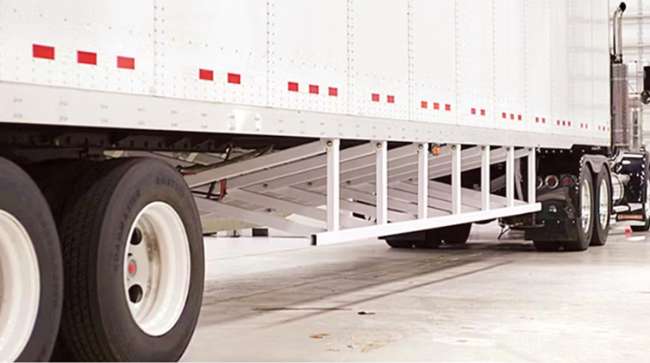Senior Reporter
Divided Final Report Issued on Side Underride Protection

[Stay on top of transportation news: Get TTNews in your inbox.]
Two trucking industry trade groups are criticizing a report issued by members of a specially appointed federal committee on trailer underride protection as lacking in true consensus across the full committee, noting that the report recommended a variety of so-called urgent and sweeping safety regulation actions that the two groups and others stress are impractical and lack support among key stakeholders.
Included in the report — supported by a slim majority of committee members — was a recommendation to launch a rulemaking to consider mandating side underride guards on heavy trucks.
“Instead of collaborating and focusing on ways to prevent [commercial vehicle]-related crashes from occurring in the first place, the 400-plus page final report dismissed industry concerns, recommended unrealistic and unproven crash mitigation devices, and misrepresented consensus recommendations by including information that had not been discussed during committee proceedings,” said Dan Horvath, senior vice president of regulatory affairs and safety policy for American Trucking Associations. Horvath represented ATA on the committee, and was among a minority group of members that issued a separate report urging against side underride guards due to, among other things, a lack of research data on their effectiveness.

Horvath
“I’m thankful that industry members were able to provide a dissenting ‘minority’ report as well as individual dissenting reports,” he said. “Anyone reading the final report will clearly see that this was by no means a consensus recommendation.”
“Over the course of these meetings, the committee on underride protection failed to work in a collaborative and consensus fashion,” said Todd Spencer, president of the Owner-Operator Independent Drivers Association, in a letter written to House Transportation and Infrastructure Committee leaders. “Safety advocacy representatives manipulated their numerical advantage in the committee membership and approved a motion to define ‘consensus’ as a simple majority that minimized opposing viewpoints of other committee participants.”
Spencer’s letter added, “The National Highway Traffic Safety Administration should not advance potential new underride standards until further research, analysis and testing is completed as directed in the bipartisan infrastructure law. The only recommendations that garnered true consensus support among panel members generally involved enhancing research and reporting. As such, these are the only elements of the final report Congress and USDOT should take seriously.”
The so-called majority report called on federal regulators to require that heavy trucks be equipped with side underride guards, a highly controversial idea in the industry. The majority report, made public last month, recommended several safety regulatory actions including:
- All semi-trailers and single-unit trucks should be equipped with side underride guards that should additionally protect vulnerable road users.
- The National Highway Transportation Safety Administration’s rear underride guard rule should be amended to meet the Insurance Institute for Highway Safety’s ToughGuard standard, or equivalent, and apply to all trailers and single-unit trucks.
- The Federal Motor Carrier Safety Administration and NHTSA must expeditiously complete a heavy vehicle automatic emergency brake rulemaking for all classes of commercial motor vehicles.
- NHTSA should issue an advanced notice of proposed rulemaking for front impact guards and harmonize with global front override regulations.
- FMCSA should issue stronger conspicuity tape requirements and have them apply to all classes of CMVs, including single-unit trucks.
- The Department of Transportation and NHTSA should prioritize additional research to prevent underride crashes as recommended in the committee report.
The committee, comprising stakeholders from across the truck and trailer industry, safety organizations, crash victims, insurance companies, law enforcement, crash reconstruction specialists and more, deliberated for over a year in fulfillment of its congressional mandate to provide advice and recommendations to the DOT secretary and Congress on safety regulations to reduce underride crashes and fatalities relating to underride crashes. The group met six times over the past year, most recently on May 25. Discussions were often tense.
A leader of the majority group stressed action must be taken.
“Nothing is stronger than an idea whose time has come,” said committee Chair Lee Jackson, an investigator with Fort Worth, Texas-based Traffic Crash Reconstruction. “Preventing underride crash deaths and injuries is an exceedingly attainable goal. This report cuts through the noise and provides clear recommendations, that if followed, will undoubtedly save lives.”
“There were a lot of decisions or votes that were unanimous votes,” Jackson told Transport Topics after the group’s final meeting in May. “And there was some division.”
Want more news? Listen to today's daily briefing above or go here for more info
The majority noted that, per NHTSA, in 2023 fatalities in crashes involving large trucks reached nearly 5,900 (not restricted to underride-related crashes). In addition, there were over 160,000 injuries.
In the minority group’s report, several members made clear that they did not concur with the final recommendations of the majority.
“Regarding side-underride guards, further investigation is needed to assess their effectiveness in preventing fatalities and injuries, as well as the specific crash scenarios leading to those outcomes,” the minority report said. “Additionally, research should explore potential unforeseen consequences resulting from adopting side-underride guard technology, such as additional fatalities or injuries resulting from damage to trailers, high centering, and increased trips required by cargo displacement.”




